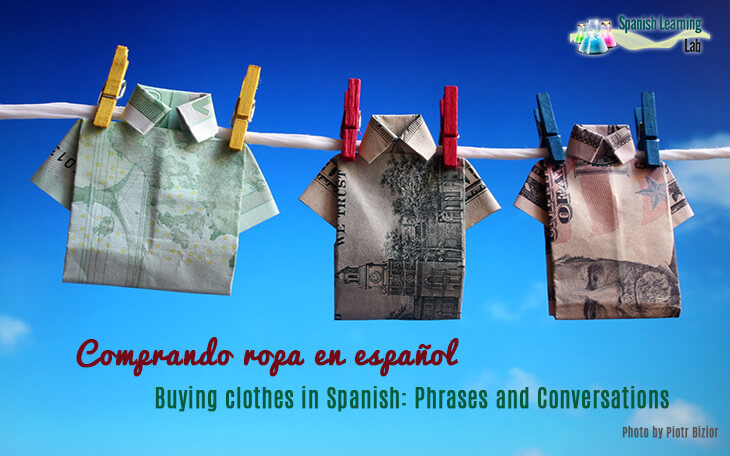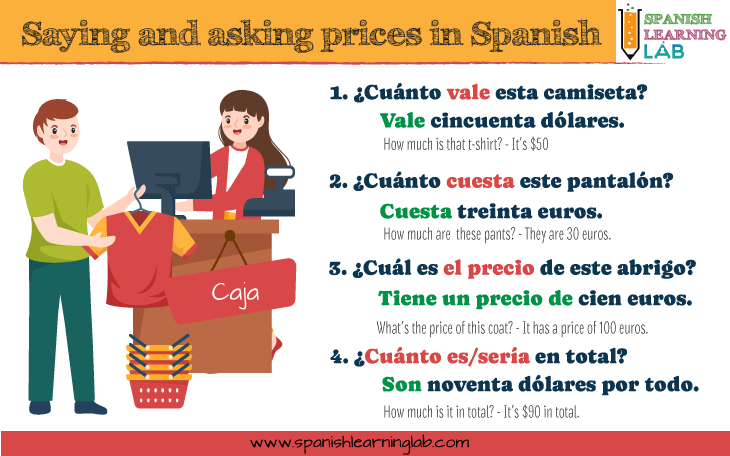In the past two lessons, we covered the vocabulary for clothing items and prices as well as some common adjectives to describe them. This lesson will teach you some basic phrases and questions you can use when shopping for clothes in Spanish, plus some ways to say what you are wearing in Spanish too. This time, we will see all these things in use through sample conversations in Spanish at a shop and other places. You will be able to practice with two interesting listening activities and quizzes.

Vocabulary review: Clothing in Spanish, prices and descriptions
Let’s start the lesson by reviewing the vocabulary for clothing in Spanish with a nice video inlcuding several pictures and some important notes. The video will review how to make simple sentences to describe clothes with adjectives, talk about clothing styles and patterns, the basic use of the verb USAR (to wear), how to ask for prices and more. You can activate the subtitles (cc) below if you need them.
Shopping for clothes in Spanish and saying what you are wearing
Describing clothes in Spanish at a shop
First, to describe clothes in Spanish, you can use the verbs LUCIR (to look) and SER (to be). We can use them following structure: [Prenda de vestir (clothing item) + SER/LUCIR + adjective in Spanish], for example: “Tu camisa es bonita”. When shopping for clothes in Spanish, you can also use adjectives to say what you think about the items you are buying, for example: “La camisa está cara”, “El pantalón está barato”, etc.
It is also important that you know how to say clothing sizes and styles so you can say clearly what you are looking for, like in these two sentences which make use of the present progressive in Spanish: “Estoy buscando una falda de talla mediana” and “Estoy buscando un vestido floreado”. Also, in order to ask for an opinion about clothes we may use the questions: ¿Qué opinas de esta + prenda de vestir? and ¿Cómo me queda esta + prenda de vestir?. Listen to the first sample conversation where someone is shopping for clothes in Spanish at a shop and find some of the phrases we have introduced so far.
Example No. 1
- Nely: Jorge, ¿te gusta mi vestido nuevo?
- Jorge: Si. Te ves muy elegante. El vestido es muy bonito. Te queda bien
- Nely: Gracias. Me gusta el color de este vestido. Compré unos aretes y unos zapatos de tacón para usarlo
- Jorge: Esos zapatos son bastante altos ¿te sientes cómoda?
- Nely: Claro. Es muy fácil caminar con ellos.
- Jorge: Mi novia prefiere los zapatos bajos… Creo que a ella no le gustan los zapatos de tacón, pero te quedan muy bien…
Example No. 2
- Jorge: ¡Hola! ¿Tiene ropa para niños?
- Vendedora: Si, pase por favor. Tenemos pantalones, camisetas, shorts, ropa interior, calcetines… ¿Qué está buscando?
- Jorge: Bueno, quiero comprar un pantalón azul y una camiseta blanca… también quiero una gorra y una chaqueta de color negro.
- Vendedora: ¿Qué talla?
- Jorge: Creo que talla pequeña. Es para un niño de 8 años…
- Vendedora: Entiendo… veamos, estos le quedarán bien entonces
- Jorge: uhmm sí, creo que si… no me gusta mucho la gorra, ¿tiene en otros estilos?
- Vendedora: Si aquí están
- Jorge: Excelente. Entonces me llevo todo esto. ¿Cuánto es en total?
- Vendedora: Son 39 euros señor.
- Jorge: Muy bien. Gracias
Asking for prices and trying on clothes in Spanish
In order to ask for prices of clothing items in Spanish, you can use the information questions ¿Cuánto vale/cuesta + prenda de vestir? For saying prices, we generally use the verbs COSTAR and VALER in their conjugations CUESTA and VALE, for example: “Cuesta 10 dólares” or “Vale 10 euros”. It is important to use words to describe the clothes you want such as “sencilla”(plain), “de puntos”(dotted) or any other to point out the specific item to buy.

In addition, when buying clothes in Spanish, you can ask if you can try on some clothes by saying “¿Puedo medirme este/estos + prenda de vestir?” and say which things you are buying with “Me llevaré esto/estas”. The key verbs here are MEDIRSE/PROBARSE (try on) and LLEVAR (to take).
Example No. 3
- Nely: ¡Buenas tardes! Estoy buscando una falda de puntos y una blusa sencilla de color blanco.
- Vendedor: Claro que si señorita. Tenemos varios estilos de faldas. Hay faldas floreadas, de puntos y cuadriculadas también…
- Nely: La verdad es que prefiero las faldas de puntos ¿Cuánto vale la falda celeste y cuánto cuesta la rosada?
- Vendedor: La falda celeste vale 25 dólares y la rosada cuesta 32 dólares. La rosada es un poco más cara pero la tela es mejor.
- Nely: Entiendo ¿Puedo medirme la falda rosada y esta blusa también?
- Vendedor: Si claro. Aquí está el probador…
- Nely: Vaya, se ven bien… Me llevaré estas dos ¿Cuánto es en total?
- Vendedor: Son 32 dólares por la falda y 15 por la blusa… en total, 47 dólares
- Nely: Está bien. Aquí tiene. ¡Gracias!
Saying what you are wearing in Spanish
Finally, the verb USAR will be used to talk about what you are wearing in Spanish. USAR means both to wear and to use in the language and can be used like this: [Subject + ESTAR + USAR (gerundio) + prenda de vestir]. ESTAR plus a verb in gerund is used for actions in progress or happening at the moment of speaking. ESTAR will change its conjugation depending of the subject of the sentence, but USAR will keep its gerund form (USANDO) for any subject. Here are two examples: “Yo estoy usando una camiseta” and “Ella está usando un vestido”. Listen to a last sample conversation about the clothing items someone is wearing in Spanish.
Example No. 4
- Nely: Hola Jorge. Mira, estoy usando el abrigo que me regalaste… Combina bien con este vestido.
- Jorge: Nely, vaya… te ves muy guapa. ¿Cómo me veo yo?
- Nely: Muy elegante con tu camisa a cuadros, tu pantalón de vestir y ese sombrero… te ves divertido
- Jorge: Gracias… la verdad es que quería vestir casual. Vine a la fiesta con mi novia, pero no la veo
- Nely: ¿Qué está usando ella?
- Jorge: Ella está usando una falda verde, una blusa blanca y algunos accesorios en el cabello….
- Nely: uhmm… mira, ahí está
- Jorge: Es cierto. Te dejo entonces. ¡Que disfrutes la fiesta!
Listening Activity No.1: Buying clothes in Spanish – Comprando ropa
Key expressions in the conversation:
- ¿Puedo ayudarle en algo? means May I help you?
- ¡Solo llevaré esto! means I will just take this!
Listening activity No.2: “What are you wearing?” in Spanish
Key expressions and questions:
- Te ves muy guapa means “You look very beautiful”
- ¿Crees que luzco bien? means “Do I look good?”
- Te queda bien ese atuendo means “You look good on that outfit”
Related Spanish Worksheets:
- Men’s Clothes in Spanish – PDF Worksheet
- Women’s Clothes in Spanish – PDF Worksheet
- Shopping in Spanish at a Store – PDF Worksheet
- Shopping for Clothes in Spanish – Dialogues in PDF

La música es muy difícil de escuchar.
Gracias por tu sugerencia. Un abrazo